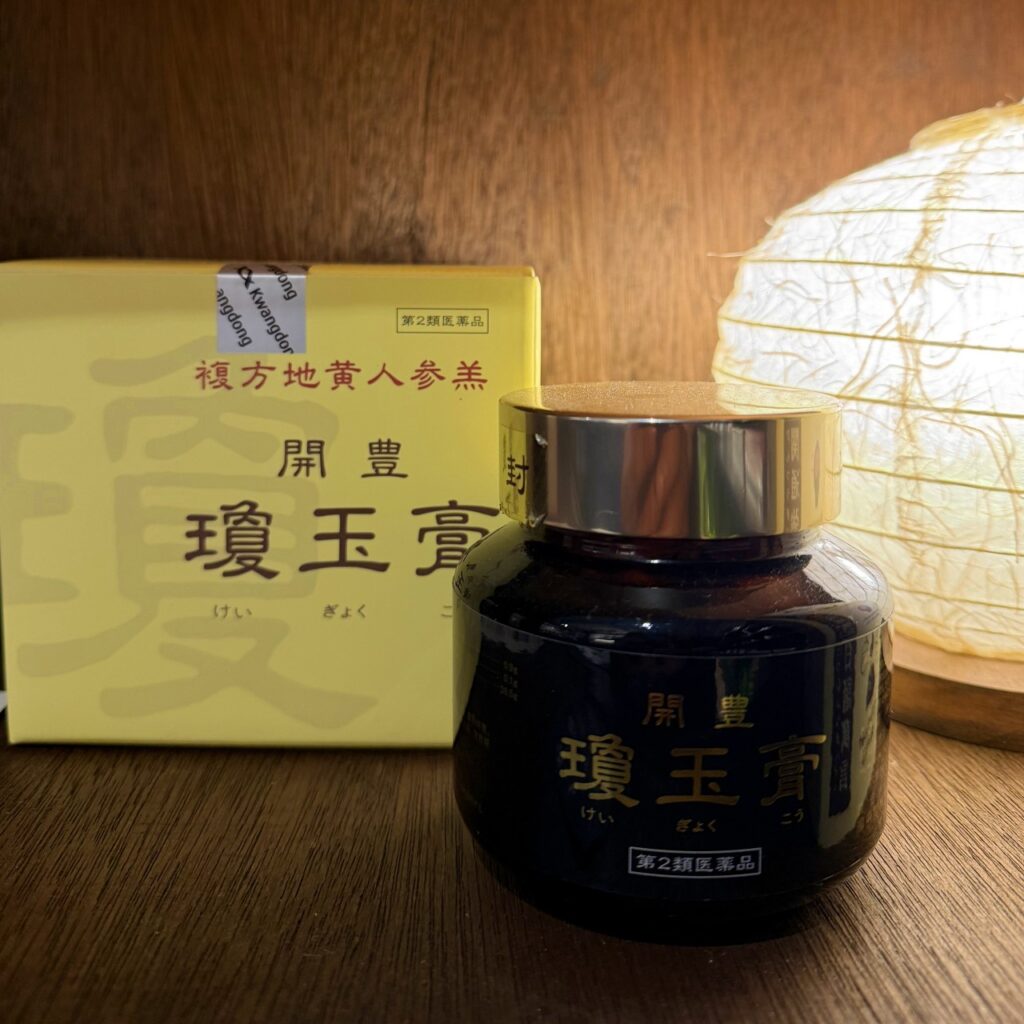In the Edo period, there was a Kampo medicine beloved even by the Tokugawa shogunate.
It is called Keigyokukō (瓊玉膏).

In Kampo, medicinal formulas are classified into three categories: 上品Jōhin (Upper Grade), 中品Chūhin (Middle Grade), and 下品 Gehin (Lower Grade).
For example, medicines used to deal with acute pain, sudden fever, symptom flare-ups, or detoxification — such urgent situations — are classified as Gehin (Lower Grade).
They are powerful and effective, but they come with stronger side effects.
Upper Grade medicines, on the other hand, can be taken by men and women of all ages, whether sick or healthy, with almost no side effects, working gently and steadily over time.
瓊玉膏Keigyokukō is an ancient formula, recorded as early as 1170 AD in the Koshi-keikenho/Hongshi Jingyan Fang (洪氏経験方), written during the Southern Song dynasty.
It is said that it was created and named with the wish that the emperor and his descendants would prosper eternally without decline.
It was known as a noble elixir — a tonic of immortality and beauty, nurturing life force and vitality.
In modern terms, it is a daily rejuvenating and anti-aging tonic, excellent for recovery from fatigue and maintaining everyday health.
Just as Qin Shi Huang, the First Emperor of China, pursued an elixir of immortality, rulers throughout history have sought medicine and healing methods for health and longevity.
Among them, Keigyokukō was cherished by successive Chinese emperors as a medicine that maintains the harmony of the internal organs and supports long life in good health.
Over time, it was refined through various dynasties and was even transmitted to the royal court of the Joseon Dynasty in Korea, and from there, it eventually reached the Tokugawa shogunate in Japan, where it was highly valued.
The famous Korean royal physician Heo Jun (허준 / 許浚, 1539–1615) also recorded an improved version of Keigyokukō in his classic medical text Toi-hokan/Dongui Bogam (東医宝鑑, 1613).
In that text, it is described as:
“A medicine that replenishes life-force, promotes longevity and rejuvenation.
It compensates for countless deficiencies and eliminates numerous diseases.
When taken, energy fills the organs; white hair returns to black, lost teeth grow back, and the body runs like a swift horse.
If taken two or three times a day, one will not feel hunger throughout the day, and it delivers many other benefits.
First, it expels excess fluids and phlegm-related disorders; continued use cures chronic fatigue.
Taken for 27 years, one may live to 360 years old; taken for 64 years, one may reach the age of 500.”
Of course, the latter part is highly exaggerated, but as a medicine originally created in pursuit of longevity and even immortality, it reflects the mindset and aspiration of the era.
In another classical text, Keigyokukō is described in this way:
“Keigyokukō replenishes Essence and Qi, supports the digestive functions, provides all necessary nutrients, nourishes the five viscera and six bowels, strengthens their activity, fills the bone marrow with blood, turns the white hair of the elderly black again, allows them to run like a spirited horse, removes hunger when taken several times a day, sharpens memory, enhances thinking, and brings deep sleep without dreaming.
If taken before the age of 27, one may live to 360 years; if started before the age of 45, one may reach 240 years; if begun before the age of 63, one may live to 120 years; and even if started after the age of 64, one can still fulfill a life of 100 years.”
Exaggerated or not, it clearly shows that this medicine was considered a superior elixir for recovery from fatigue and anti-aging.
It is prescribed for those with Qi and Blood deficiency, to prevent aging and promote longevity, and it is still produced in Korea today using traditional methods.
In the Edo period, there was a special government post called 火付盗賊改方Hikitsuke Tōzoku Aratamegata — an office responsible for suppressing crime such as arson, robbery, and illegal gambling, in order to protect the city of Edo.
One of the most famous samurai who held this position was Hasegawa Heizo Nobutame (長谷川平蔵宣以, 1745–1795).
He later became the model for novels, which were adapted into drama and film, making him well-known even in modern times.
It is said that when he retired due to age, he was personally awarded Keigyokukō by the 11th shogun, Tokugawa Ienari, in recognition of his service — a famous anecdote passed down to this day.
A blend of several medicinal herbs and honey is gently steamed and heated over several days, and even today it is carefully produced by a pharmaceutical company in Korea.
Because it has a natural sweetness, it is easy for children to take.
Modern Therapeutic Benefits (Expressed in Contemporary Terms)
• Blood sugar regulation in diabetes
• Loss of appetite or overeating
• Anxiety disorders, school refusal
• Tonic for fatigue and weak constitution (loss of appetite, physical exhaustion, post-illness recovery, weak digestion, poor circulation, cold constitution, during growth)
• Osteoporosis
• Mental stress
• Postpartum recovery, infertility
• Growth support and anti-aging
• Immune system enhancement, antioxidant action
• Diabetes and its complications
• Hypertension
• Gastric ulcers
• Memory impairment and dementia prevention
As you can see, it is a broad-spectrum tonic, and at Kakikofu Clinic, it is one of the most cherished Kampo medicines we provide.
Would you like to try the same Kampo formula once taken by samurai and shoguns?
Kakikōfū ― Jiyugaoka, Tokyo
Hiroshi

